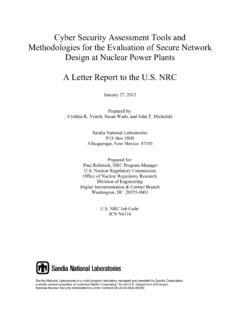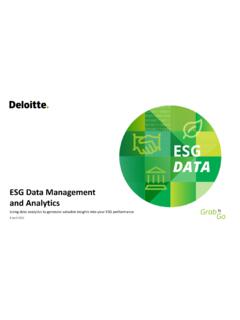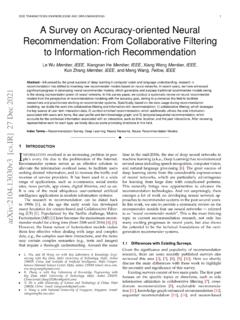Transcription of 2022 manufacturing industry outlook - Deloitte
1 2022 manufacturingindustry outlook 2022 manufacturing industry outlookManufacturers eyeing growthIt is unusual to see positive economic indicators paired with historic labor and supply chain challenges. But this is the trajectory for US manufacturing in 2022 emerging from the pandemic. The recovery gained momentum in 2021 on the heels of vaccine rollout and rising demand. As industrial production and capacity utilization surpassed pre-pandemic levels midyear, strong increases in new orders for all major subsectors signal growth continuing in Deloitte projections based on the Oxford Economic Model (OEM) anticipate GDP growth in manufacturing of for As capital expenditures rise, a combination of high business valuations, strong earnings, and low-cost debt may also encourage companies to add technology capabilities, gain share, and expand in new markets with M&A.
2 Policy initiatives and infrastructure investment have the potential to contribute to manufacturing s recovery. However, optimism around revenue growth is held in check by caution from ongoing risks. Workforce shortages and supply chain instability are reducing operational efficiency and margins. Job openings at more than twice the gap to reach pre-pandemic employment levels hover near all-time highs at more than 800, Sourcing bottlenecks and global logistics logjams are likely to remain challenges in 2022 along with cost pressure and inflation risk.
3 Steel, aluminum, and other commodity prices have surged amid Adding to this mix are risks from COVID-19 variants, cyberattacks, environmental challenges, and higher corporate tax rates. The industry can expect elevated uncertainty from a range of potential disruptors globally. Business agility can be critical for organizations seeking not only to operate through the turbulence from an unusually quick economic rebound but to compete in the next growth period. Manufacturers with higher digital maturity before COVID-19 had an advantage to some extent with greater resilience, as did those that accelerated digitalization during the Today, digitalization spanning smart factory initiatives to enterprise transformation and e-commerce can be vital for a more sustainable and competitive future in manufacturing .
4 Eighty-six percent of manufacturing executives we surveyed report they are somewhat or very positive on business, up from 63% in 2020. As leaders look not only to defend against disruption but strengthen their offense, there are five important trends to consider for manufacturing playbooks in the year the Deloitte survey To understand the outlook and perspectives of organizations across the energy, resources, and industrials industries, Deloitte fielded a survey of more than 500 US executives and other senior leaders in September 2021.
5 The survey captured insights from respondents in five specific industry groups: chemicals and specialty materials, engineering and construction, industrial products, oil and gas, and power and manufacturing industry outlook3 Preparing for the future of work could be critical to resolving current talent scarcityRecord numbers of unfilled jobs are likely to limit higher productivity and growth in 2022, and last year we estimated a shortfall of million skilled jobs by 2030. Talent scarcity is compelling more manufacturers to consider raising pay.
6 Although the industry has historically had a higher baseline wage for production workers, some competing industries are increasing wages faster than As digitalization transforms manufacturing work, automation of recurring tasks could help to blunt some of the labor shortage s impact. Organizations may also have more incentive to pull forward future-of-work strategies by re-architecting work, rethinking the composition and capabilities of the workforce, and adopting flexible and innovative workplace attract and retain talent, manufacturers should pair strategies such as reskilling with a recasting of their employment brand.
7 Shrinking the industry s public perception gap by making manufacturing jobs a more desirable entry point could be critical to meeting hiring needs in 2022. In our survey , 38% of executives report that attracting new workers is their top priority for the production workforce in 2022, followed by retention (31%) and reskilling (13%). Reputational harm from a history of moving jobs to lower cost regions or outsourcing remains a generational challenge for some manufacturers to overcome. The industry may need to deploy creative solutions to improve workforce perception and experience.
8 Placing a spotlight on modern facilities, advanced technologies, career mobility, well-being, and purpose can further attract new entrants, re-entrants, and those reconsidering employment with a wider talent ecosystem of partners to reach diverse, skilled talent pools could also be essential to offset the recent wave of retirements and voluntary More manufacturers are revisiting requirements for candidates, considering ways to make online and in-person application easier, and expanding outreach to systemically disadvantaged groups.
9 As partnerships, workforce development programs, and reskilling all remain important, efforts for diversity, equity, and inclusion (DEI) are increasingly a business imperative. More organizations are adding leaders to advance their DEI journey from a focus on meeting representation targets to creating more inclusive environments where diverse talent can build executives may need to balance goals for retention, culture, and innovation. Remote work for office workers was one of the early successes for business continuity in the pandemic and has changed the minds of many employees and employers.
10 Hybrid and flexible work models will likely continue to evolve. As flexible work is taking root in offices, manufacturers should explore ways to add flexibility across their organization in order to attract and retain workers. Organizations that can manage through workforce shortages and a rapid pace of change today can come out shortage12022 manufacturing industry outlook4 Manufacturers are remaking supply chains for advantage beyond the next disruptionSupply chain resilience has been a thread through our recent outlooks, and the challenges are acute and still There is no mistaking that manufacturers face near-continuous disruptions globally that add costs and test abilities to adapt.















